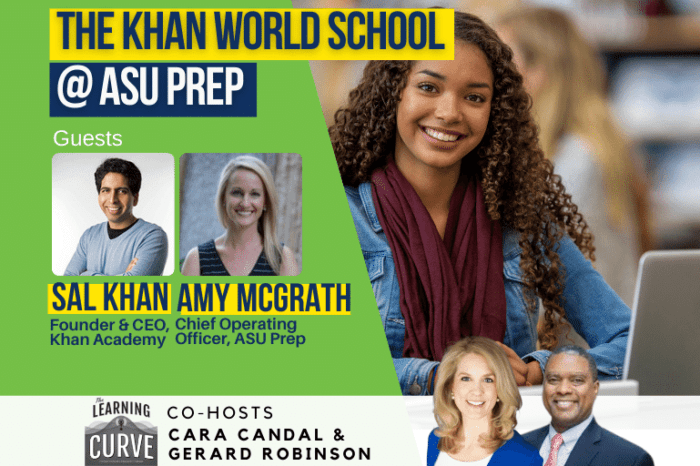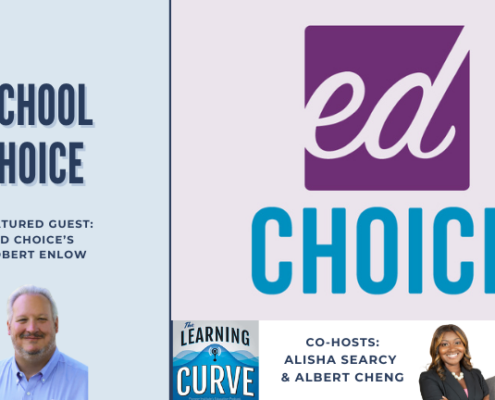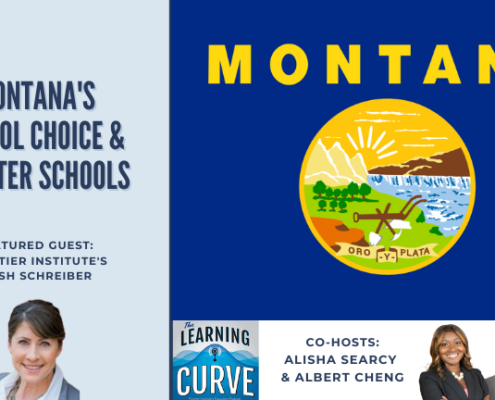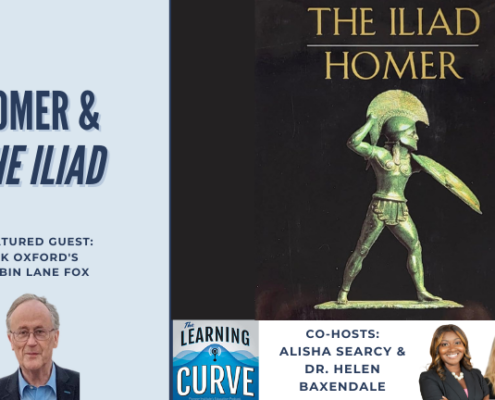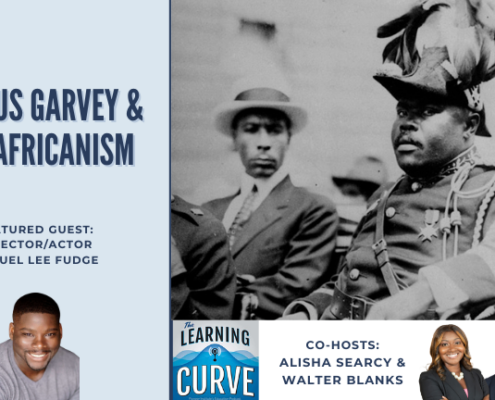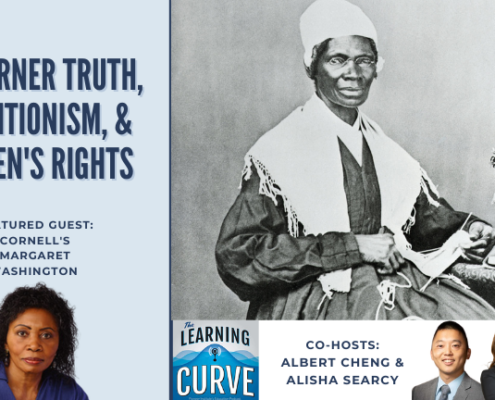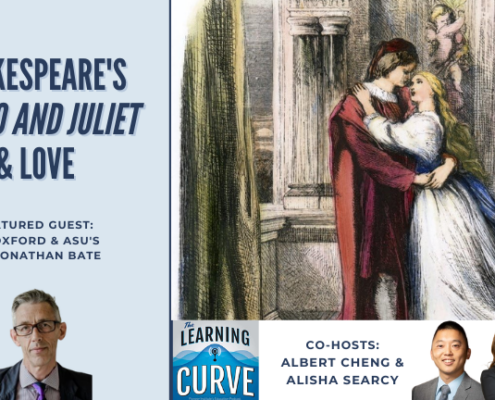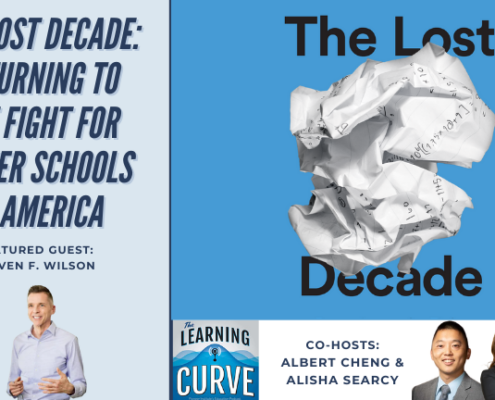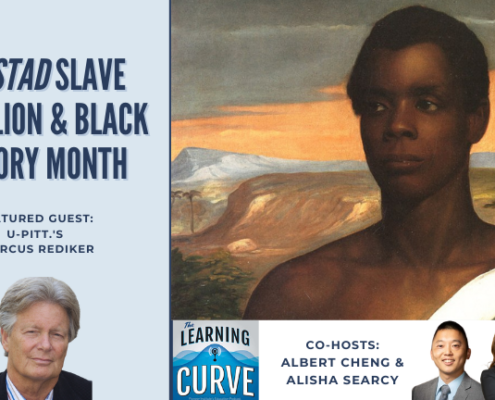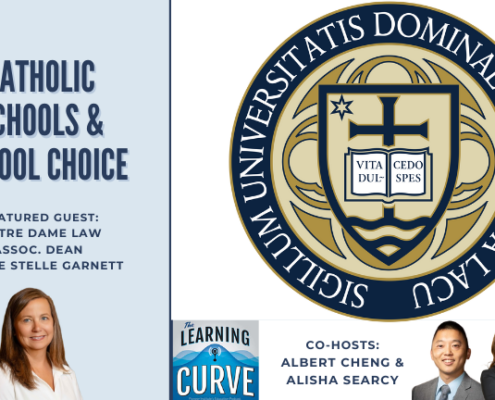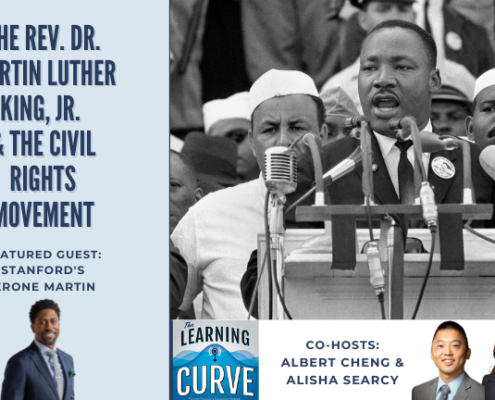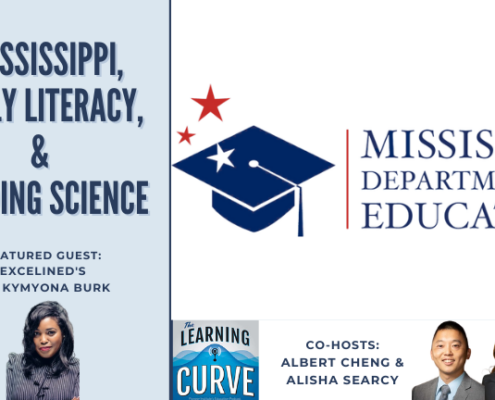Khan Academy’s Sal Khan & ASU Prep Digital’s Amy McGrath on the Khan World School @ ASU Prep
This week on “The Learning Curve,” Cara Candal and Gerard Robinson talk with Sal Khan, founder and CEO of Khan Academy, and Amy McGrath, the Chief Operating Officer of ASU Prep and Deputy Vice President of ASU Educational Outreach. Mr. Khan shares the origin story of his wildly successful online K-12 education platform, which reaches 137 million users across 190 countries. Mr. Khan describes how he and his team develop academically rigorous lessons and translate them into videos to ensure kids have access to the highest-quality academic content. Ms. McGrath explains how innovations like Florida Virtual School (founded by current ASU Prep Digital CEO Julie Young) more effectively meet 21st-century families’ needs than the current K-12 American public education system, which is still based on the factory model and agricultural calendar. They discuss how the new partnership between Khan Academy and ASU Prep will enhance online education and address learning loss in the post-COVID era.
Stories of the Week: Many welcomed President Biden’s recent announcement of a loan forgiveness plan for up to $20,000 in student debt – but it excludes holders of private loans. Is physical education undervalued in schools?
The next episode will air on Weds., October 5th, with Karega Rausch, the President and CEO of the National Association of Charter School Authorizers.
Guests:
 Sal Khan is the founder of Khan Academy, a nonprofit organization with the mission of providing a free, world-class education for anyone anywhere. Khan Academy’s content and mastery learning platform has more than 135 million registered users from around the world and has been localized into more than 51 languages. The organization partners with school districts across the country that serve students who are historically under-resourced. Sal holds three degrees from MIT and an MBA from Harvard. He has been profiled by 60 Minutes and was recognized as one of TIME’s 100 Most Influential People in the World.
Sal Khan is the founder of Khan Academy, a nonprofit organization with the mission of providing a free, world-class education for anyone anywhere. Khan Academy’s content and mastery learning platform has more than 135 million registered users from around the world and has been localized into more than 51 languages. The organization partners with school districts across the country that serve students who are historically under-resourced. Sal holds three degrees from MIT and an MBA from Harvard. He has been profiled by 60 Minutes and was recognized as one of TIME’s 100 Most Influential People in the World.
 Amy McGrath is the Deputy Vice President of Educational Outreach and Student Services for Arizona State University and Chief Operating Officer of ASU Prep and ASU Prep Digital, ASU’s K12 network of schools. With over 15 years of experience exploring innovation and personalized learning in the field, she has a rich background which ranges from school design to marketing strategy and educational policy. A nationally recognized educational technologist, Amy prioritizes learner-centered models, and works to increase access to high quality learning for every student, regardless of zip code. Amy has her Bachelor of Science and MEd from the University of South Florida, and she is happily married with 3 children who keep her weekends eventful on the side-line of a soccer field.
Amy McGrath is the Deputy Vice President of Educational Outreach and Student Services for Arizona State University and Chief Operating Officer of ASU Prep and ASU Prep Digital, ASU’s K12 network of schools. With over 15 years of experience exploring innovation and personalized learning in the field, she has a rich background which ranges from school design to marketing strategy and educational policy. A nationally recognized educational technologist, Amy prioritizes learner-centered models, and works to increase access to high quality learning for every student, regardless of zip code. Amy has her Bachelor of Science and MEd from the University of South Florida, and she is happily married with 3 children who keep her weekends eventful on the side-line of a soccer field.
Tweet of the Week:
Jupiter is making its closest approach to Earth in 59 years. Here's how to watch. https://t.co/G5hVGnC9aG pic.twitter.com/5nvkrdHBU7
— CNN (@CNN) September 26, 2022
News Links:
Student Loan App Sparrow Raises $7 Million For Bid To Simplify Private Borrowing
History of physical education and youth sports: why there’s no chill option for kids
Get new episodes of The Learning Curve in your inbox!
Read a Transcript of This Episode
Please excuse typos.
[00:00:00] GR: Hello listeners. Welcome to another Wonderful Soon to Be Conversational Learning Curve. As you know, every week we bring on really interesting guests, but of course, nothing could take place without my partner in Rhyme here. How are you?
[00:00:38] Cara: Do I have to rhyme now?
[00:00:40] GR: Rhyme isn’t always. Like X and y, it’s rhythm, it’s space, it’s pace.
[00:00:47] And so we’ve been rhyming for, in fact, a two weeks ago was my hundred 25th show, so we’ve been rhyming for a while,
[00:00:53] Cara: for 125 weeks. That’s pretty amazing because s listeners know like, we don’t really take a week off do weger [00:01:00] our cuz we just enjoy rhyming so much.
[00:01:02] GR: We like to rhyme and time. Yep.
[00:01:06] Cara: Oh, well it’s good to hear your voice.
[00:01:08] It sounds. Well, I’m happy that you are and I’m excited for today’s show. We’ve got some cool
[00:01:13] GR: guests. Yeah. In fact, I’ll be the first time I’ve had a chance to speak to, well, both, but one in particular who most of our listeners will know by name. So this as usual, you know, will be a good show. I want to thank of course Jamie McKayla the team for the great work they do in bringing us wonderful.
[00:01:30] Cara: Yeah. Oh, absolutely. Absolutely. I know my kids were particularly excited about Salcon being on the show because they, really do u like and use Khan Academy, so it’s good. And my daughter, two
[00:01:41] GR: younger daughters do as well.
[00:01:42] Cara: Yeah. Yeah. So what are you thinking about this week, jar? Well, I’m
[00:01:46] GR: thinking about a conversation we had a few weeks ago when we talked about the loan forgiveness program that Biden supported as I said then, as I will say now, was a promise made, a promise kept, and it’s to forgive up to [00:02:00] $20,000 in loans for people who make I think under 125,000, but one group of people missing from.
[00:02:08] Are students or adults who have private loans, they’re actually excluded from the plan. Ding, ding, ding. Yep. Ding, ding, ding. And I was like, Really? So I read a really good article by Emma Whitford. She is a staff writer at Forbes, and the title of the article is Student Loan App Spar raises 7 million to bid to simplify private borrowing.
[00:02:31] So we know about what took place. A lot of people cheered. And then I said, Well, you know, people take out private loans for a holster reasons. And when you think about it, it’s because tuition costs money. So, for example, although private loans make up a relatively small share of the student debt during the 20 20, 21 academic years.
[00:02:53] Guess what? Student borrowers still took out close to 12.5 billion in non-federal [00:03:00] loans, and this is according to the college board’s latest trends in college pricing and student aid report. Something I recommend our listeners should read. So even though $12.5 billion in non-federal. Sounds like a drop in the bucket.
[00:03:15] It’s still 12.5 billion that borrowers took out in the last academic year. Students take out a loan for host of reasons, private, public, otherwise. One is to pay for tuition. So according to the report in 20 21, 20 22 the price tag for a four year in. School was 10,740. If you decided you wanted to go to a public four year school, you were out-of-state student.
[00:03:44] The price tag, $27,560 two year in district, 3,800 by far the lowest. And I’m a big proponent of two year colleges as a graduate of one and the last private nonprofit four year. [00:04:00] $38,070. And so when you take a look and you say, Well, tuition’s going up, people have to pay for it. where’s the bulk of the money going?
[00:04:09] So, according to the report in 20 21, 22 undergrad and grad students receive the total of 230. 4.9 billion in student eight in the form of grants. Federal work study, federal loans and federal tax credits. 6.2 million PE grant recipients at the tune of 26 billion as part of that group, but by far institutional grants, what universities give to students.
[00:04:33] 71 billion that counts for roughly 50% of all student name. And even though 12 point 5 billion in. Federal aid is what was borrowed. That’s a 34% increase over the last decade in terms of how many private loan borrowers have increased. Now, at the same time, you’ve seen roughly a 10% drop for those who are in the public market for [00:05:00] a loan.
[00:05:01] So there were three people and one of them is a student at Stanford University. In fact, he’s a grad. Effort. His name is Harrison Hopman, and Harrison realized along with some of his friends, that when the pandemic hit. People had to return home. All of a sudden they realized just how refinancing or financing school became a challenge.
[00:05:24] So he and his co-founders, Griffin Morris and Danielle Kahn in 2020 decided to create Sparrow. And so when Hogan was asked why in particular he did it, He said, when all of our friends got sent home, we saw firsthand very immediately the problem of private student lending and the type of burden that it thrust on young adults as they graduate college.
[00:05:48] We had to do something. And so Sparrow is an online app. And it’s free. And it allows the user to submit a short application. [00:06:00] And in return they will receive a list of lenders that the user is eligible for any would personalize rate. In fact, hope, and refers this as the Expedia of student loans. And if any of our listeners had to go through the process of getting a loan be it private public, or a combination thereof, You know, there’s a lot of paperwork that you have to go through.
[00:06:22] And so with Sparrow, it’s a one stop shop. You submit online, it’s a short application, and then you will have an idea of what lending organizations to go to. Now what’s interesting about this from an entrepreneurial standpoint, Is that there are obviously some people in the marketplace who thinks this is a good idea.
[00:06:40] So the company recently received 5.83 million in a seed investment from Soso Ventures, and to date Sparrows raised 6.7 million. Spar works with 17 lenders, including Sally Ma. SoFi Ascent College app, and the goal is to [00:07:00] make sure that schools across the board, public, private, two year, four year, decide to join.
[00:07:06] Now, as you and I know, having spent some time in higher ed, there are challenges in the private lending market. One challenge is often the rate is. To borrow, then you would find in the public market. Number two, the private lenders are highly regulated, and so there’s some other challenges that go along with getting loans.
[00:07:25] But with Sparrow, they’re saying, We hope schools decide to do something differently and actually join on board to help us out. Now, according to. Justin Drager, who’s the president and CEO of the National Association of Student Financial Aid Administrators. He said, Yeah, a lot of universities simply won’t offer students information about preferred private lenders.
[00:07:47] They either use internal lenders or the public ones because of some of the challenges I mentioned. However there is one director at Pfizer College in California who initially. Took a hands off approach on getting [00:08:00] involved with the administrative burdens that come along with private lending.
[00:08:03] But according to Cara Moore, who’s at Pfizer, she said, after taking a look at the app, Pfizer’s now one of 17 colleges that route students who are looking for private loans to spar and sent to that point, several other organizations and schools have come on board. So as we think about. Students with loans, there are students who have private loans.
[00:08:23] Their loans matter. They still have to pay those off. And it was a few, I guess, three entrepreneurs who decided during the pandemic to come up with the way to help borrowers left behind. What are your thoughts?
[00:08:36] Cara: Well, I mean, I think people don’t realize that a lot of times folks have to take out private loans, in part because they’ve exhausted their public options.
[00:08:43] Mm-hmm. and people forget that, covering the cost of college is one thing, but, being able to attend college means also being able to support yourself through it. And so people take out loans for a variety of reasons that we don’t talk about in this country. And it’s a very interesting idea.
[00:08:57] I love that there’s an app for that. I love [00:09:00] that somebody’s working to , simplify things. Quite entrepreneurial. I am waiting Gerard for the app though, that addresses the crux of the problem, which is not loan forgiveness, but the fact that the cost of higher education is just out of reach for so, so, so many.
[00:09:13] So I’m waiting for the next story. Sparrow, somebody else, somebody out there. Can you develop an app to help us be better consumers Of, what we’re buying when it comes to higher education, because I think that that’s a big learning curve for a lot of folks as well. what’s gonna be the roi?
[00:09:28] There’s some out there, but certainly it’s not simple to understand. Gerard, I’ve got sort of. I’m thinking of it as a light story of the week. It’s something that really like tickled me and I, I found it informative. I’m not saying that it’s light in, in the sense that it’s not informative, but it made me think about my childhood.
[00:09:46] I would you like to know a fun fact about my childhood, Gerard related to my story? I do. Okay. So picture this my mother. Was a marathon runner when I was growing up. And so she would routinely go on very, very long [00:10:00] run. 16 miles I can remember quite vividly. And when she would do this, because she was spending so much time away from the house and away from her kids when she was running, she would actually make my.
[00:10:10] Younger brother and I go with her and we would have to ride our bicycles alongside my mother as she would drill us in multiplication facts, make us diagram sentences, all sorts of things. And I remember this not only is really great quality time with my mom, but I remember it as. The learning experience for me.
[00:10:27] She also complained a lot about my school, I have to say, as she would always say, Oh, that school’s not teaching you how to diagram a proper sentence. She would be very upset with that. But this relates to my story, Gerard, which is entitled, Why American Kids Grow Up Hating Exercise, And it is about physical education in this country.
[00:10:45] It’s from Slate uh, Natalia Mellman Pet. I’m gonna say her name incorrectly. Forgive me, Natalia Petre. And I just thought it’s a nice read. Things that I would not have guessed about the, history of physical education in this country. [00:11:00] For example, Gerard I don’t know if you knew this, but we’ve had physical education in school since as early as like 1929.
[00:11:07] As more and more people, like as cities grew, there were these pushes for playgrounds and in exercise through play and all these sorts of things. And that sort of got incorporated. Into our school. So that was in the 1920s and the playgrounds were by the thirties. We had physical education in schools in the fifties, as you can imagine.
[00:11:27] Physical education through John F. Kennedy and others. they emphasized the importance of physical education from military readiness, because you can remember, I mean, right, this was Sputnik, the beginning of the Cold War. This was a really big thing and. This article makes this really interesting point about how there was this moment.
[00:11:46] sort of in the middle of the last century where physical education became this sort of inclusive thing for kids because it wasn’t all focused on sports. Right. Today. Well, we can talk about what physical education looks like in schools today, but [00:12:00] a lot of sports are very competitive now, especially if you can afford.
[00:12:03] For people to tell you for example, that your child is really good at soccer or hockey or baseball or whatever, and for x thousand dollars a year, you too can be in this prestigious league, right? It’s a whole different industry today than we had back then. But in, terms of schools, like, you go from this moment where physical education is being integrated into the schools and then where it’s an inclusive thing, even in up to the 1970s, right?
[00:12:28] When we start to make sports. More accessible to women under Title nine to women and girls in sports. That’s in part because physical education, that time was something that girls were doing in school. It was something that all kids were doing in school and led to the growth of competitive sports.
[00:12:46] So it’s really, really fascinating stuff. And part of this that I love is thinking about my own physical education experience. I’m sure you probably remember yours too, teacher growing up in the eighties. I don. On memories of the presidential test of physical fitness, I have [00:13:00] always been an athlete and I enjoy all different sorts of forms of exercise in sport.
[00:13:04] But I remember that dearly, it talks about the eighties though, as sort of a decline in the heyday of phy ed in schools as being something that was good and sort of productive. Because the eighties is when fitness became an industry really for adults. So you think about the birth of the gym that people would go to, that people go to now today, right?
[00:13:25] Fitness classes aerobics classes for, at the time suburban moms. Right? It’s a really, really interesting sort of romp. Through the history of physical education. Unfortunately, where it lands today is something that we hear too much of all the time, which is that phys a in schools today, either there’s not enough of it, there’s not enough movement, integrated movement period in schools or it’s just of low quality, unfortunately, for some kids.
[00:13:51] And the pandemic, of course, has highlighted, we’ve talked about. , the issue of kids being sedentary in this country for a really long time. But the pandemic, I think for many, highlighted it. I [00:14:00] know my own kid’s school tried, Oh goodness gracious. Online physical education classes and God bless ’em.
[00:14:05] They tried to get those kids moving, but they were doing it while they were attached to a screen because we were all locked in our homes two years ago. So a really interesting article, Gerard, it made me think a lot about both the good and bad parts. The physical education of my youth. But I highly recommend this read to anybody that’s interested in the history of how we tried to get kids moving in school and where it sort of all fell apart, which I think is where this article lands.
[00:14:32] And I must say, if you don’t have time to read the whole thing, just look at the pictures because man, some of them are absolutely fantastic and appreciative. So Gerard, highly recommend that to you. If you, maybe you wanna give us just one thought, like one sentence memory of physical education or gym class from your youth.
[00:14:49] GR: In high school we had a co-ed physical education course, and so it was the first time I played football with women. First time for basketball. [00:15:00] And also I think first time for track. So it was just memorable in the aspect that, sports were segregated for all the reasons we know today. A little more integration.
[00:15:12] But that was interesting because in the absence of that physical education course called co-ed sports, good chance that wouldn’t have happened because it surely did not happen in the elementary. Yeah.
[00:15:22] Cara: No, it’s really interesting stuff and I think it is an opportunity to introduce kids to a lot of the sports and games they wouldn’t otherwise know.
[00:15:29] Well, Gerard, I mean, I could talk about this article forever, but we’ve got two great guests actually coming up. So in just a moment, we are gonna be bringing on Sal Khan. Many of our listeners will know him. He is the founder and CEO of Khan Academy. We’re also gonna be talking to one of his partners in crime, so to speak, Amy McGrath.
[00:15:45] And she. COO of ASU Prep and Deputy Vice President of ASU Educational Outreach. We’ll be right back with Sal and Amy after this.[00:16:00]
[00:16:21] Learning curve listeners, we’ve got two fabulous guests with us today. We are speaking with Sal Khan. He is the founder of Khan Academy. My kids, as I said at the outset, I’m not just saying this, they really do love it. It is a nonprofit organization with the mission of providing a free world class education for anyone.
[00:16:39] Anywhere. Khan Academy’s content and mastery learning platform has more than 135 million registered users from around the world and has been localized into more than 51 languages. That’s amazing. The organization partners with school districts across the country that serves students who are, who are historically under resourced.
[00:16:59] Sal, [00:17:00] a degree from mit, in an MBA from Harvard. He has been profiled. 60 minutes and was recognized as one of time, one hundreds most influential people in the world. Scon, it is such a pleasure to have you with us. Thanks for coming on a learning curve. Thanks for having me. And I’d also like to introduce Amy McGrath.
[00:17:18] She is the Deputy Vice President of Educational Outreach and Student Services for Arizona State University and Chief Operating Officer of ASU Prep and ASU Prep Digital a’s K to 12 network of schools. With over 15 years of experience exploring innovation and personalized learning in the field. She has a rich background, which ranges from school design to marketing strategy.
[00:17:40] And educational policy. A nationally recognized educational technologist. Amy prioritizes learner centered models and works to increase access to high quality learning for every student regardless of zip code. Amy Hasler, Bachelor of science and e d from the University of South Florida, and she is happily married with three children who [00:18:00] keep her weekends eventful on the sideline of a soccer field.
[00:18:03] Boy does that one ring true to me. Amy, Nice to meet you. Thanks for having me. All right, well , we’ve got a lot of questions for the two of you today, so if you don’t mind, Sal, I’d like to dig right in with you. So a lot of people are already gonna know your story, but I think that like it’s worth going over a little bit of it here before asking you about this partnership.
[00:18:22] So you began tutoring your 12 year old cousin in 2004 and then posted these wonderful instructional videos on YouTube to Khan Academy and it’s now got. 137 million users across 190 countries, Billions of views, this global enterprise. Okay, So talk to us a little bit about your own upbringing and background, How this came to be, of where you came from, and then give us a little insight into this new partnership with ASU Prep.
[00:18:51] Sal: Sure. You know, I was born and raised in New Orleans and when I was getting married in 2004, as you just mentioned, my family from New [00:19:00] Orleans was visiting me in the Northeast where my wife’s family’s from New Jersey. And it just came outta conversation that my 12 year old cousin needed help.
[00:19:08] So I offered to tutor her. Long story short, it. Kind of worked. She was having trouble with unit conversion. She got through unit conversion and then became a tiger Cousin called up her school and said, I really think Nadia should be able to retake her placement exam from last year. They said, Who are you?
[00:19:21] I said, I’m her cousin. And they surprisingly allowed her to, and that same Nadia was then put into an advanced track. I was somewhat hooked. Word spreads in my family that free tutoring is going on. Before I know it, I’m tutoring 10, 15 cousins and I saw common pattern that the reason why many of them were struggling wasn’t cuz they weren’t bright or hardworking or that the subject matter was difficult.
[00:19:40] It was because they had, they needed more practice. They had these days people call it unfinished learning. They had gaps in their understanding that was holding them back, especially in math. And so, I started writing software for them. I. Did that before making any videos. I called it Khan Academy cuz it really was a bit of a family project.
[00:19:55] And then in 2006, a friend suggested that I make YouTube videos to [00:20:00] supplement the software. I thought it was a horrible idea. I told him YouTubes for cats playing piano . but I gave it a shot and that got a life of its own. My cousin’s famously told me they liked me better on YouTube than in person and more important.
[00:20:14] People who weren’t. My cousins started to use it and send me letters about how it was, in many cases, transforming their lives. So you fast forward then to 2000, you know, 2004, I started tutoring cousins 2005, writing the software, 2006, making YouTube videos the whole time. I’m an analyst an investment fund, at a hedge fund, first in Boston.
[00:20:31] Then we moved out here to Northern California. But by 2008, 2009, I frankly had trouble focusing on my day job because, So exciting being able to impact folks this way. So that’s when I set up Khan Academy as a not-for-profit with a mission of free world class education for anyone, anywhere. And then I quit my day job in 2009 to work on it full time.
[00:20:51] We had about 50 to a hundred thousand users at that point. that first year was very tough, trying to get the philanthropic support to get it off the ground. But by [00:21:00] fall of 2010, we had some major philanthropic supporters, and that’s what’s allowed us to now go on this journey that you described.
[00:21:07] Cara: it’s just amazing. I mean, I, I just have to, Could you ever imagine that your name would be a household name related to teaching math?
[00:21:16] Sal: Well, know, it’s, a good , leading indicator for where that household is going. If I am a, a household name in it, But I, I.
[00:21:24] Cara: Very good point. Very good point.
[00:21:26] I mean, I think, that we love it, and I’m sure, I know it was big before the pandemic, but you, you, my friend, saved a lot of people, a lot of parents, a lot of grief and heartache and headache, during the time of remote learning. And that’s in part a little bit what this new partnership.
[00:21:40] it’s more than just supplementals. But let me have Amy describe a little bit and then I wanna get to that. So, Amy, we have talked in the past to the Florida Virtual School founder and CEO of ASU Prep Digital, Julie Young. she’s been ranked of course, as among some of the most important pioneers in the history of American education.
[00:21:57] Can you talk a little bit? [00:22:00] About the principles of educational leadership and the climate of achievement that you and Julie together have fostered at ASU Prep. And then maybe tell us about this collaboration and what you do at ASU Prep really is so, in sync with what Sal
[00:22:15] Amy: does. I think saying in sync is the perfect way to capture all of what we have experienced so far with Sal and at ASU and ASU prep.
[00:22:24] We just believe that all kids can learn and we are really focused, laser focused on mastery models and that was a perfect Inroad for a match made in heaven with Sal and his team. It’s also the spirit which births Florida Virtual and it’s at the heart of the charter for Arizona State University.
[00:22:43] And it’s really, President Crow has commissioned us to create whatever models are needed to ensure all kids learn cuz it’s a massive commission and there needs to be really well thought out and disruptive transformational models available to kids across the [00:23:00] proficiency scale. And so this particular model is really geared towards kids who are ready to sprint in our.
[00:23:08] Kind of bored at all of the ceilings that they’re experiencing in what maybe is a traditional model offered to them. So when Sal approached me just to talk about and collaborate on this concept, a concept he’d been thinking about for quite some time there were just fireworks going off because it’s something that really resonated with me with our organization and it was a perfect.
[00:23:33] Cara: That’s amazing. I love this idea of kids who are ready to sprint. if I may for just a moment, my own 12 year old daughter who were very pleased with her education in her school, but her teachers actually recommended that if she wanted some supplementals, she should use Khan Academy. And she had a flip like a moment about a.
[00:23:50] Year ago where she came to my husband and me and she said, You know, I really love math. I’m ready to sprint, Sort of was what she was telling us in her own words. [00:24:00] So thank you so much for thinking about, I mean, you’re thinking about all kids, right? in all of the various work that you do. So, Sal, let’s go back to you for a moment.
[00:24:08] tell us a little bit more about the dynamic of this partnership? Okay. And what it looks like to Blend Khan Academy and ASU Prep. How did it meet the needs of the pandemic and how is it going to help with the learning loss that we know so many kids have experienced?
[00:24:25] Sal: actually picking up on that, the narrative of my narrative on Khan Academy, if we pick up where we left off around 2010, 2011, we’d gotten our first philanthropic funding. Khan Academy was getting a lot of notoriety and it was quickly getting to the many millions of, learners were coming every month.
[00:24:41] I always aspire that, hey, maybe this could be a, catalyst for more general transformation in education. If students could get lectures and videos and practice and articles at their own time and pace. Well, maybe that could liberate what happens in the classroom. Maybe we could allow students to finish any unfinished learning they [00:25:00] have.
[00:25:00] And in 2011, 2012, I wrote a book called The One World Schoolhouse, where the first third of the book was Why is the Education System structured the way it is today? The middle third was my journey that I just talked to you about, and the last third was, Let’s think first principles about what the school system should be like or could be like given tools like Khan Academy and given what we needed in the world going ahead, more knowledge workers, et cetera.
[00:25:24] So I wrote that, and it’s one thing to write a bit of a utopian idea type book, but I was really chomping at the bit to put it into practice. And so in 2014, And I was somewhat selfishly motivated. My oldest child at the time was entering kindergarten. We decided to start a lab school literally under the offices of Khan Academy.
[00:25:44] It’s a separate organization, but it’s called Con Lab School. And the whole idea was, Hey, can we prove out some of these ideas from the one World School house that you can have students learn at their own time and pace, have more agency than they’re typically given. While also super charging what the teachers can do and [00:26:00] empowering what they, but maybe the role changing a little bit so that they’re more guiding the students, mentoring them, or taking them through projects or interactive things.
[00:26:08] So that school, fast forward to now, or a couple years ago, it’s become a K12 school is doing quite well, but it’s still a small scale lab school in Mountain View, California. and it still has the aspiration of, hey, can this model scale? Obviously this one school with 250 kids isn’t going to scale to change the world, but maybe it can share systems, et cetera, Take that.
[00:26:31] And at the same time, the pandemic hits and we all know what happened. A lot of systems had to migrate to remote learning really overnight, and it wasn’t necessarily optimal for most kids. And I’m not pointing fingers at anyone actually. Overall people did a good job considering the circumstances, but it showed the need for maybe taking some of these ideas of Khan Academy and Con Lab School.
[00:26:57] And then putting it into a virtual environment that can both [00:27:00] scale and that also can show the world that there is a way to do online and virtual that instead of taking away from community or human interaction, can actually give to those ideas. So we started exploring starting an online high school version of Con Lab School and I talked to a advisor Michael Horn, who’s been a friend for a long time, very aligned philosophically, and he says, Sal, this is a great idea.
[00:27:25] I said, Michael, do you know any interesting people to talk to that would know the space? Well, he said, you have to talk to Amy McGrath. She’s the rock star here. I talked to Amy and Amy, and you can ask her for her own words, but she was kinda like, Oh, I love this idea. And I’m thinking, Wow, Amy’s already done so much at ASU Prep as part of, essentially their online high school.
[00:27:46] But she seemed intrigued about doing model that was a little bit more mastery learning personalized like this focus on daily seminar, but then leverage Khan Academy and appropriate ways, leverage other tools. And by the end of our conversation, it, it was a. [00:28:00] I kind of said, Hey, you wanna do this together, , and Amy was kinda like, I was hoping you would ask.
[00:28:04] She said something like that. I forgot the exact context, . But that’s, what got it started because it, you know, it is able to take the vision and the ideas and whatever thought leadership I might have been able to provide. But all of what Amy and the ASU prep team have done over the years and their thought leadership and put it together and it’s really a match made in.
[00:28:22] GR: Well, sticking with the Amy as rockstar theme . Um, My question in fact is a good lead in to what Sal just said. I mean, you two now have a partnership and with Covid you had an opportunity to really show your craft unique ways. What lessons, you know, can someone like me or someone in Alaska or someone anywhere in the world.
[00:28:42] What are some of the best practices that we can take from what you’ve learned and what you’ve implemented as relates to online learning? Not post covid, but just the next wave of learning.
[00:28:55] Amy: Oh, that’s such a great question. I would just say that flexibility [00:29:00] really needs to be at the heart of a lot of the newly designed models.
[00:29:04] It’s sort of an expectation for employees and families and students and as you and I think all of us know. sometimes I even hesitate saying factory model, but the agricultural calendar that is the public education system is something we need to use c And so, that’s an example of outcome based thinking.
[00:29:25] But the problem with that is that that was American society a hundred years ago. So as we’re thinking about new models we’re thinking about, the outcome as. What does the world need now and what does the world need leading us into the next a hundred years of educating? And we learned a ton just in those short last two years.
[00:29:44] I say short, but that felt like an eternity. And so since so many people experienced covid in such various ways, Either from home or from work or some were even blocked from learning cuz they didn’t have the infrastructure available.[00:30:00] We just really have thought, about design that is centered on a student, not on a school building, not on a school structure.
[00:30:08] And really have taken it as a responsibility for equity but also to ensure that every student has access to really high quality education. Cuz it is possible now, and it may not have been 50 years ago or x number of years ago when we were designing things that were harder to deploy and, very physically anchor.
[00:30:30] So, that’s part of the design principles and some of what we’re learning for moving forward. But again, I just anchor back , to mastery and really believing that every student can, but they all do in different ways. So if it takes you three months for Algebra one, Amazing. Keep going. If it takes you 18 months for algebra one, that’s okay.
[00:30:51] You need to keep going back so that you don’t have a really faulting foundation. You gotta do it and you have to do it really well to be able to move on to the next [00:31:00] subject. And so, designing models with that principle as well as really Just doubling down on community, which is hard to do in a remote environment.
[00:31:09] But we learned a lot from the requirement for all of us to be at home for so long that we need, I mean, our hypothesis that kws is that learning happens best in community and so, We need the students to be interdependent and apply their knowledge that they’ve gained, not just alone, but with each other on real world topics.
[00:31:32] and that means doing that in dialogue and the Socratic seminar style dialogue with other students. And so those are some of the things that we’ve learned and the designed and through Sal’s concept are putting into practice now with our students.
[00:31:45] GR: Great response on so many fronts. So Sal, one of the criticisms about K-12 education long before the pandemic is that There’s a gap between academic expectations and the curricular [00:32:00] goals, not only for the best performing schools here in the US but some of our peers across the globe. And you’ve done a lot, , through high quality instructional videos, try to disclose that gap. Could you discuss how you and your team have developed academically rigorous lessons, how you’ve translated the written word in the videos, and what’s your vetting process to ensure that students who have access to it.
[00:32:22] Are getting the best available
[00:32:23] Sal: content. I think in terms of the potential critiques, this isn’t of any individual actor or system, but really just where we’ve gotten to historically. It’s that our system right now is very seat time based and it does come outta the industrial revolution where the way to the idea of mass public education was a very utopian one.
[00:32:43] So it’s done a lot of good in the world. I, don’t wanna minimize that, but there were compromises batch students together usually by age, maybe age, and perceived ability, move them through curricula at a fixed. Have some lectures, homework, lecture, homework. Then do a test. [00:33:00] Even if a student didn’t master the material, they got a 60, 70, 80% of that test.
[00:33:04] The class moves on to the next concept. building on though that 20, 30, 40% gap and those gaps keep accumulating and at some point kids hit a wall. And this isn’t theoretical. If you look at kids in America, going to two year and four year university, so this is generally only about 60% of American.
[00:33:23] High school graduates or American students are even trying to go to university. And of the ones that do, the majority aren’t even placing into college algebra. And college algebra really, I believe is still should be a remedial course at a college level because it’s essentially 10th or 11th grade math.
[00:33:40] So when you have a majority of the top half of kids, arguably a very large majority of all, After 12 or 13 years of education, let’s say I’m picking on math in this situation, cuz it’s especially pronounced, they go to college, they’re trying to do the right thing, and the colleges say, Wait, you have so many gaps in your learning, we’re gonna take you all the way back to middle school.
[00:33:59] Which [00:34:00] essentially is what happens and it has all sorts of negative consequences for those students. This isn’t just some weird edge case, this is a majority of students in America. What we try to do, what we’ve tried to do at Khan Academy and we’re do it kws and KLS Con Lab School. Make it so that teacher, either a student on their own, can make sure they always have the opportunity, the incentive to fill in any gaps they need, be able to learn at their own time and pace, have the practice.
[00:34:26] And as much as we’re known for videos, we actually think the practice part of Khan Academy, which has a functionally infinite item bank, is where the actual learning happens. We just had some efficacy studies that show that if students put in even 30 minutes a week, they’re growing 50% faster than their peers.
[00:34:42] Because they’re getting more practice, more feedback at their actual. Zone of proximal development or actually at their, their, their learning edge in terms of, and kws just doubles down that on that and makes a whole school a around that. But I, , just to the question on that you asked Amy, I think what we’re really doubling [00:35:00] down on kws is all of these ideas of mastery learning, personalization, but also realizing that if you’re going to do something remotely, if you’re gonna do an online school, you.
[00:35:08] Triple down on the human element. And so that’s why we’re doing daily seminars and check-ins, kind of Oxford style tutorial structures in terms of how we at Khan Academy, vet content videos I have a team that I still make a lot of videos myself, but we have other folks, they’ll say, Hey, we’re trying to hit this standard, et cetera, et cetera.
[00:35:27] I actually try to do the videos without, in fact, I never use a. I don’t do any editing or very limited editing because I think it’s very important for people to. Feel that the instructor is thinking it along with them and being very transparent with their thought processes. So a lot of the worked examples, for example, I’m seeing that problem the first time while I’m doing the video, and I think that’s part of the secret sauce.
[00:35:50] Obviously after that point, we have folks will take a look at it if there’s any problems, maybe there’s a redo. But that’s our general process exercises, articles. We have a team of expert [00:36:00] content creators who. Take first, passes have peer review, we go to external reviewers. it’s a pretty rigorous process for this content.
[00:36:08] GR: And that’s a great transition in for Amy. this partnership is very unique. People like me care are excited to see it. Would you talk more about how these two successful organizations will be collaborating on pedagogies and assessing students and achievement?
[00:36:23] Amy: I think we’ve really been beating the drum on mastery.
[00:36:27] But I’m glad Sal is also doubling down on community. I think both of those are part of our first principles. But I think some of what we’re doing is kind of audacious in a way that. we don’t have teachers, we have guides, we don’t have grades. we’re really trying to challenge ourself in that.
[00:36:45] If we believe that every student experiences learning different, and in order to master something, you might need access to a course all the way through what we call 12th grade. It makes a lot of people uncomfortable to [00:37:00] think about that. And it also from a design. A full standpoint requires us to completely rethink the silos of subjects and the ways learning guides are certified what community learning looks like.
[00:37:14] So,, if society wants rankings and GPAs and all of the grade inflation that goes with that, this is gonna be a bit of an audacious model, but, Because we’re so outcomes focused I think you’ll, be able to see that our students are really mastering the skills because our goal is learning and, really truly learning to the point where a student’s confidence explodes because of what they’ve mastered.
[00:37:42] And what they’re able to use and apply in real world situations. That’s something that’s really prevalent in what Sal and his team have accomplished over the last several years. And it changes everything. So, we’re just grateful for some amazing families and incredible kids and really [00:38:00] adventurous learning guides who are trying this out with us to really scrap grades and you know, instead of saying you get a, b.
[00:38:08] It’s either get mastery or you’re in progress. kind of pushing ourselves to ensure that we can do that really well and keep the light of mastery as our direction. I think we’re gonna be able to see some really powerful stories of students progressing quickly, even through university level credit and carrying that into what their next phase of life.
[00:38:31] GR: Here’s a closing question for both of you, and I’m gonna borrow the rock and roll metaphor. So we have Amy rockstar, Saul Rockstar, you come together. Rock and roll. History is just littered with examples of superstar coming together and then the band not staying together. What’s the secret sauce that’s going to, let’s say for the next three years keep the band playing cause you got some great c.
[00:38:57] Sal: Well, you know, this, this is obviously one of my fears cuz [00:39:00] when we started working together both as individual actors but also our organizations, it did feel at many times, and it continues to feel almost too good to be true cuz we’re completing each other’s sentences. We’re very aligned on who’s doing what, et cetera.
[00:39:13] crossed, I think it’s looking good because now that the school has even started, We continue to be very aligned and all the times that I’ve seen the band break up and I’ve been members of startups, and even within Khan Academy, sometimes team members who didn’t get quite along, it was always an alignment issue.
[00:39:30] And I think what’s really, really powerful here is I don’t feel like I’m pulling teeth with the ASU team on. Mastery learning or personalization or daily seminar. If anything, they’re pushing me on the things that I care about and, vice versa. So I think and yeah, I think as two, not for profits, we also have the same bottom line around social impact.
[00:39:49] So that’s also kept us really aligned. But I don’t wanna jinx it, but, you know, fingers crossed Amy. Yeah,
[00:39:54] Amy: I, I would agree completely. We, spend so much time [00:40:00] nodding at what one another says, and I mean that for our, teams. And and then really bringing back outcomes of how the model is actually performing in pilot mode.
[00:40:10] So from a, music metaphor perspective, I think, we’re certainly a, a band that’s not gonna break. We, we do talk very frankly about, okay, what do, like, how are students prioritized in this entire process? Cuz in this model it is a hundred percent not about the adults. So, two very well known organizations coming together that are, try something out no matter what this.
[00:40:33] At all emphasises on the students. And I think that focus away from ourselves and onto the kids keeps us what we’re really, really good at bringing to the table. So I think it’s gonna, it’s gonna be, continue to play out and in a way that there’ll be a lot of stories to be told and the scale will continue to happen.
[00:40:53] GR: Well, Amy and Saul, thank you so much for uh, joining us. This was a great conversation. If you need backup members whenever [00:41:00] uh, need someone to fit in care plays a mean harmonica and I’m pretty good with the base, so from an educational standpoint. So thank you for joining the Learning curve and we look forward to following your success.
[00:41:12] Thanks for having us. Thank you guys. Take care.
[00:41:51] So Cara, my tweet of the week is from cnn, September 26th, and it says, Jupiter is making its closest approach to [00:42:00] earth in 59 years. Here’s how to watch. And so for our listeners, go to our homepage. You can click onto it, and I am going to be. One of the people watching.
[00:42:11] Cara: Yeah. I’m gonna go to our homepage and click on it.
[00:42:14] That’s fantastic. I love it. Gerard, thank you for pointing that out. Well, listen, it’s that time, it’s time for us to say goodbye until next week. And Gerard, I hope that our listeners will come back and join us again next week because as always, we’re gonna have another great guest. We will be speaking to.
[00:42:31] Karega Rausch, the president and CEO of the National Association of Charter School, Authorizers, you and I do love a good charter school authorizing conversation, Gerard, don’t we? We do. All right. You take care of my friend. We’ll talk charters. You do next week. Bye bye.
[00:42:47] GR: See you next week.[00:43:00]
Recent Episodes

